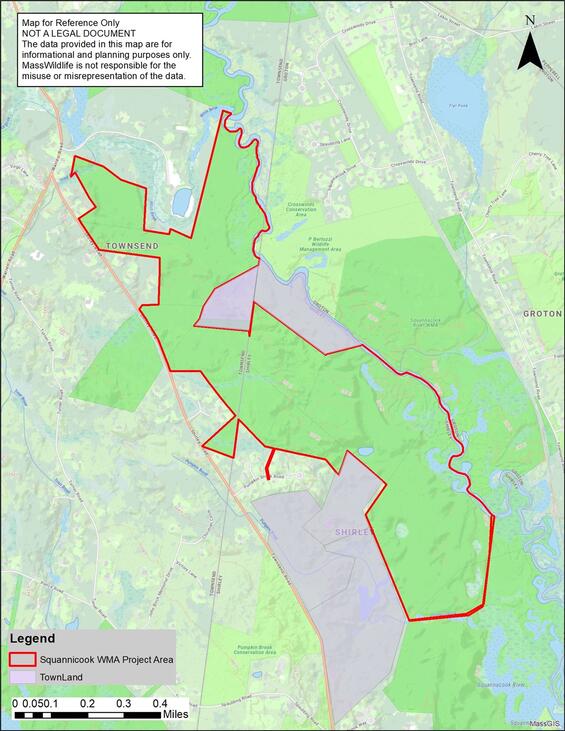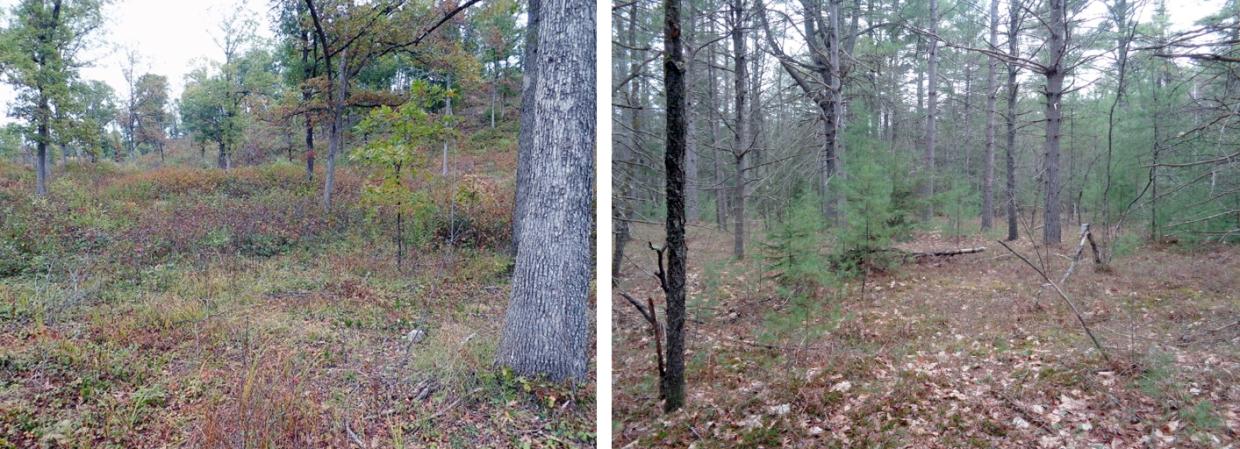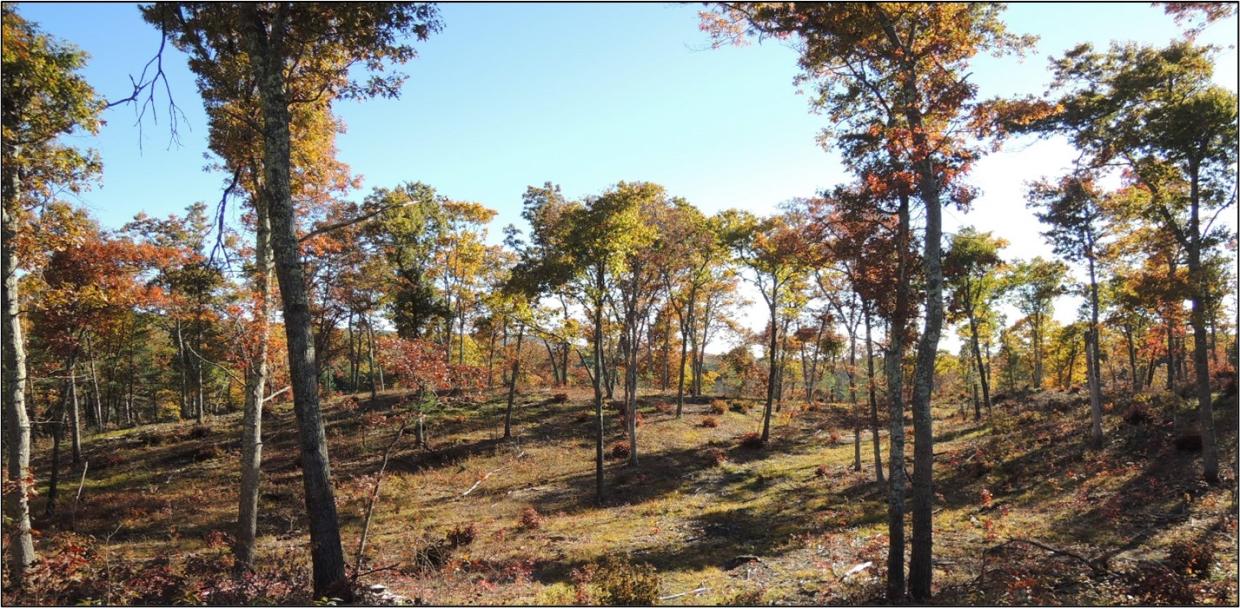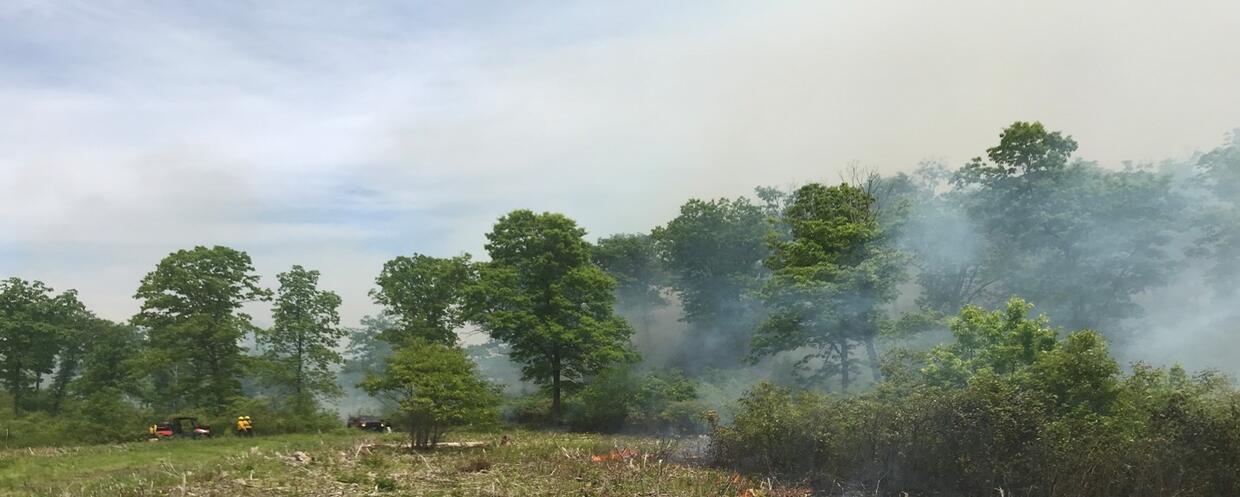Why do these communities need to be restored?
The Squannacook River Wildlife Management Area (WMA) provides an important opportunity to restore a significant group of fire-influenced Oak Woodland natural communities (i.e., habitats including Black Oak-Scarlet Oak Woodland, Pitch Pine-Scrub Oak Woodland, and Open Oak Woodland). Within the woodlands are smaller areas of related fire-influenced communities including Inland Sandplain Heathland and Inland Sandplain Grassland. These are classified as Priority Natural Communities in Massachusetts.
Prior to European colonization, oak woodlands covered thousands of acres in the Commonwealth supporting an diverse group of birds, mammals, insects, amphibians, and reptiles (see article The Mighty Oak), yet oak woodlands are almost nonexistent today. These fire-influenced habitats are critical to numerous wildlife and plant species identified in the MA State Wildlife Action Plan and many species also listed under the Massachusetts Endangered Species Act (MESA), making this project at Squannacook River WMA one of MassWildlife’s highest priorities for restoration.
Unfortunately, the majority of oak woodland habitat at Squannacook River WMA is in severe decline. The absence of disturbance—most notably fire—has resulted in a closed canopy forest dominated by very common trees such as eastern white pine and red maple that have shaded out the understory. This shading prevents growth and reproduction of important shrubs, grasses, and wildflowers that many wildlife species, especially native pollinators, depend upon. Oak woodlands ecosystems require periodic disturbance events, in most cases fire, to maintain a semi open forest canopy and a diverse understory that provides the food and cover important for wildlife. Although the current dense shaded forest is providing habitat for some species, they tend to be wildlife and plants that are common and have populations that are doing well throughout their range.
How is a woodland different from a forest?
A woodland primarily differs from a forest in canopy closure and the amount of sunlight that hits the forest floor. A forest has a closed canopy permitting very little light hit the ground. There are often several overlapping layers of trees with a mid-story and a sparse understory comprised of shade-tolerant plants
A woodland has a wider spacing of trees and a more open park like canopy and a limited mid-story that allows more sunlight to reach the ground. This light permits growth of a variety of shrubs, wildflowers, grasses, and sedges. Fire plays a large role in maintaining these woodlands and promoting the specialized plants that thrive in oak woodlands.
Fig 1. Oak Woodlands with a well-developed understory (left), Oak-White Pine Forest with limited understory (right).
What happens during restoration?
The project will begin by restoring the open structure of the oak woodland communities through a timber harvest (Fig 2). Keeping the oaks while removing tree species like white pine and red maple that would have been excluded in the presence of fire will allow sunlight to reach the forest floor to stimulate the growth of shrubs, forbs, and grasses that make up a more diverse understory. Over 85% of the oak trees within the project area will remain, including all the largest oak trees (trees to remain are marked in red paint).
Fig 2. Oak Woodland restoration site, one growing season after initial timber harvest.
The next steps will include control for non-desirable vegetation and invasive plants using herbicides, mowing, and mulching. Shortly thereafter, periodic prescribed fire will be the main tool used to assist the recovery of these fire-adapted communities (Fig 3). Restoration of these sites is coordinated and carried out by the MassWildlife’s Biodiversity Initiative team which includes biologists, restoration ecologists, foresters, and prescribed fire managers.
Fig 3. Prescribed fire carried out by MassWildlife in in oak woodland natural community.
Before any prescribed fire occurs, a prescribed burn plan is developed and approved by agency management and the local fire chief gives permission to burn. Fire activities are coordinated with MassWildlife biologists regarding MESA-listed species. All prescribed fire is conducted by highly trained personnel under direction of a qualified burn boss.
Along with long-term maintenance of these communities with periodic prescribed fire, continued ecological monitoring will occur for various plant and wildlife species including birds, lepidoptera, and herpetofauna.
How do we know these are fire-influenced natural communities?
MassWildlife ecologists identify fire-influenced natural communities across the landscape using both satellite derived data and on-the-ground biophysical data. This includes information gathered on soils, geology, plant composition, historical land use, and fire history. A team of interdisciplinary scientists at MassWildlife reviews these factors along with the potential for success before deciding to move forward with restoration. The Squannacook River WMA has the potential to be one of the best examples of a restored oak woodland in all of New England.
What about the river?
The Squannacook River is an important Coldwater Fish Resource and is a conservation priority for MassWildlife. Fisheries staff at MassWildlife have reviewed this project and are working with the habitat program during the restoration process. The oak woodlands restoration will be complimentary to the river and its myriad of aquatic resources. Care will be taken to ensure adequate shading along the river by maintaining large deciduous trees which will also promote the stability of the banks and provide a continued supply of important woody material into the river. Allowing controlled fires to burn along and into wetlands will recycle nutrients back into the soil rejuvenating wetland vegetation promoting flowering and seed production that’s needed for important wildlife cover and food resources.
What will happen to the trails on the WMA?
The extensive network of trails and dirt maintenance roads will remain and continue to be maintained on the WMA as they provide excellent fire breaks and allow prescribed fire equipment and personal to move around the property to conduct controlled burns to maintain this important ecosystem. The trails and portions of the WMA may be temporarily closed during different parts of the restoration process for public safety.
Map of restoration area



